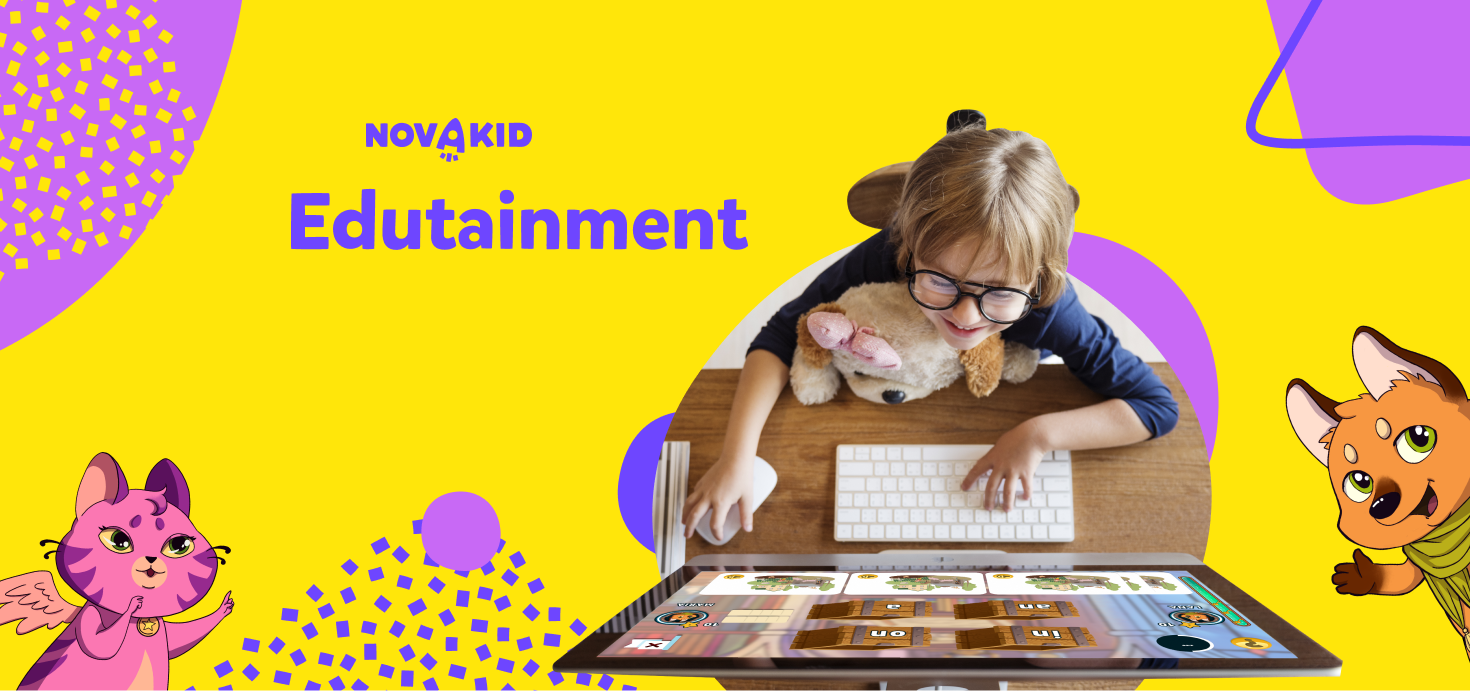- Why is understanding feelings and emotions important for kids?
- What is emotional intelligence?
- Emotional intelligence for kids – how to develop it?
- Teach your kid expressing their emotions – 6 engaging ideas
- Emotions chart for kids
- Emotions games for kids
- Develop social emotional learning for kids (SEL)
- Songs about feelings and emotions for kids
- Cartoons developing emotional skills for kids
- Books with emotions activities for kids
- Emotions in English – vocabulary to learn
Nowadays, emotional intelligence is one of the most important soft skills, which are key to a successful life. Some even say that the ability to understand ours and others’ emotions and feelings is more significant than our IQ score. As a matter of fact, emotional intelligence is presented currently as the only feature that gives us an advantage over the rapidly developing artificial intelligence.
Most of all, the ability to correctly recognize and manage emotions is the foundation of a happy life. That’s why it’s so significant to teach children about emotions and feelings from an early age. Managing emotions for kids is no easy task, since very often young children feel something, but are unable yet to fully describe it. In such situations, parents should step in and help their kids with recognizing and naming particular emotions.
In this article, we’ll explain what exactly emotional intelligence is and how to develop it in kids. We’ll talk about feeling and describing different emotions, as well as naming them in English. Make sure to check out the 6 engaging ideas for teaching children about emotions and feelings. Unlock your child’s full potential!
Why is understanding feelings and emotions important for kids?
Identifying emotions is critical for kids for a number of reasons. However, the experience of emotions is so universal and innate to us adults that often as parents we mistakenly assume that a child’s self-awareness around feelings also comes naturally.
With kids, who are not yet able to regulate emotions well, we can either neglect emotional education and shut down all their feelings, or we can support our offspring and consequently teach them about their feelings.
We choose the second approach. Here are 7 reasons why understanding feelings and emotional regulation for kids is important.
- Normalizing feelings reduces anxiety.
- Understanding emotions supports emotional intelligence.
- The ability to calm oneself reduces unhealthy behaviors.
- Working through powerful emotions supports mental health.
- Teaching children about emotions helps parents understand them.
- Emotional health is a key to physical health.
- Understanding emotions and handling them is a key to future success.
What is emotional intelligence?
Emotional intelligence is one of the most sought-after soft skills in today’s world. It is a person’s ability to manage their feelings while respecting the feelings of others.
There is no specific age at which children should start learning about emotional intelligence. In fact, the development of emotional intelligence begins at birth and is influenced by the child’s environment and their parents’ behavior. Also, since every child learns at their own pace, the development pace of emotional intelligence may differ.
However, emotional intelligence is a skill that can be trained. The simplest form of getting a child used to dealing with various emotions is to name out loud the feelings that they feel here and now.
For example, if the child is hungry and crying, we should describe the whole situation aloud, referring to the emotions that they’re probably feeling at the moment. It’s worth saying, “Oh, now you’re hungry, it makes you miserable, and that’s why you’re crying.” By using language focused on describing needs and emotions, we intentionally begin to develop the toddler’s emotional intelligence.
Emotional intelligence for kids - how to develop it?
A crucial aspect of helping children develop emotional intelligence is acknowledging and labeling their emotions in everyday situations. Playing emotional intelligence games for kids and performing social emotional learning activities for kids may also help a lot.
Unfortunately, many parents tend to downplay how their children are feeling and do not pay attention to expressing emotions. By telling a child: “Don’t cry, nothing happened” or “Stop being angry, it doesn’t make any sense”, we create in the child’s mind the idea of the so-called inappropriate emotions that should not be expressed.
Meanwhile, according to doctors, emotions are not bad themselves, only behavior triggered by emotions can be bad. In any emotional situation that your child experiences, it is always worth considering and understanding how we react when we are angry, what we say and how our body behaves.
Teach your kid expressing their emotions - 6 engaging ideas
Emotions chart for kids
An emotion chart for kids is an effective tool, which helps teach children about emotions. Thanks to the chart, kids can recognize and identify their bodily sensations, processes, etc. and communicate them. In doing so, new neurological connections are made, and a child is more likely to respond with their body according to what they’re feeling.
An emotions chart for kids should be as colorful as possible and, if needed, be carried around at all times. You never know what emotion will hit you and where. Below is an example of an advanced emotion chart* with many feelings. A simpler list of emotions for kids, in English, can be found at the end of this article.

Emotions games for kids
Educating young children will be more effective by incorporating games into their learning experiences. Children are naturally drawn to playing games, and this can be used to make learning new concepts and skills stress-free and enjoyable. One way to do this is by teaching children how to identify and name their emotions in English, while using emotion games for kids to help them practice this skill.
There are multiple emotional games that can be used for this purpose, and finding ones that are engaging and appropriate for your child’s age and development level can speed up the learning process. Here are some of our suggestions.
- Emotional charades
In Emotional Charades, kids are demonstrating one emotion at a time. The rest of the group has to guess what the emotion is. The person who is doing the charade cannot speak – they must use facial expressions or body language to make others guess the correct emotion.
Write down different feelings (from the emotions chart or emotions vocabulary list) on slips of paper. Place them in a bowl and take turns pulling them and acting them out. The person that guessed the feeling correctly scores a point and gets the next turn.
- How was your day?
Prepare colorful cards with emoticons expressing different emotions and label them in English. In the evening, before you go to bed, ask your child to name the emotions they experienced during the day. Make them choose the corresponding cards. This game will teach young children to pay attention to their own feelings and to recognize and accept them.
- Emotions Rainbow
Together with your child, imagine that each of the seven strongest emotions has its own color. And that’s why the world is so diverse! Draw your own rainbow, assigning one emotion to each color and label them in English.
For example: Happiness is Red, Sadness is Orange, Fear is Yellow, Anger is Green, Repulsion is Indigo, Delight is Blue, Doubt is Purple. After assigning emotions to colors, you can start creating engaging stories with the rainbow and tell them out loud.
Develop social emotional learning for kids (SEL)
Social emotional learning represents the set of skills your child needs to thrive throughout their life. SEL is commonly described by five core competencies: self-awareness, self-management, responsible decision-making, relationship skills, and social awareness.
These traits allow children and adults to understand their own emotions and the emotions of others, and to use this understanding in their choices and relationships. Some easy social emotional awareness activities for kids may include:
- Drawing a picture for a loved one (for younger children)
- Breathing exercises or stretching routines (for younger children)
- Writing a gratitude journal (for older children)
- Augmented Reality (AR) breathing/calming exercise (for older children)
Songs about feelings and emotions for kids
Every toddler’s parent knows that music is the key to success in this age group’s education. Teaching younger kids about emotions is no exception. Songs can be efficiently used to help your child memorize different feelings’ names and express them accordingly. Listening to English music is an activity that you can do with your kid all day, every day.
Here’s one of the most trending songs about emotions for kids, created by Pinkfong, who is behind the success of the Baby Shark song.
Cartoons developing emotional skills for kids
The Inside Out movie, produced by Pixar Animation Studio in 2015, is so far the best example of a cartoon for kids developing their emotional skills. The film centers around the psychological experiences of a young girl named Riley. Her five primary emotions (Joy, Sadness, Fear, Anger and Disgust) personified as individual characters, guide her thoughts and actions as she faces the challenge of moving to a new home.
The film delves into the inner workings of Riley’s mind and the complex role that emotions play in shaping her behavior and decision-making processes. What makes the movie even more valuable for the little ones and their parents is that, during production, the filmmakers consulted psychologists and neuroscientists in order to achieve greater accuracy in their portrayal of the mind.
Books with emotions activities for kids
Reading books about emotion regulation for kids can be beneficial for several reasons. Firstly, reading books about emotional regulation techniques for kids can help them learn to identify and name their own emotions. Secondly, books about emotions can also teach children how to manage their emotions, which is helpful in developing healthy coping strategies for handling difficult feelings. Thirdly, they also support language development and ability to use more complex vocabulary while speaking about emotions.
Some of the best examples of books for children supporting the development of emotional intelligence are: All About Feelings by Felicity Books, Mindful Monsters Therapeutic Workbook, and The Book of Human Emotions.
Emotions in English - vocabulary to learn
One of the most important steps to understanding emotions for kids is knowing how to name them. That’s why we prepared a short English vocabulary list with the most common emotions. Try to memorize as many words as possible and start using them in your everyday family communication.
- Happy
- Amazed
- Cheerful
- Excited
- Inspired
- Loving
- Passionate
- Thrilled
- Sad
- Depressed
- Disappointed
- Dissatisfied
- Guilty
- Rejected
- Remorseful
- Upset
- Weak
- Unhappy
- Scared
- Afraid
- Anxious
- Ashamed
- Concerned
- Frightened
- Helpless
- Nervous
- Worried
- Angry
- Bitter
- Cranky
- Disturbed
- Frustrated
- Furious
- Impatient
- Moody
- On edge
- Disgusted
- Sick
- Embarrassed
- Skeptical
- Calm
- Focused
- Patient
- Relaxed
- Well-rested
- Peaceful
If your child enjoys learning new vocabulary from video content, consider exploring Novakid’s educational YouTube channel for kids. You’ll find interactive videos there that can help children learn new English words in a fun and engaging way. This video about emotions-related vocabulary is just the beginning of the real adventure.
What are your thoughts on developing emotional intelligence in kids from an early age? And which one of our ideas for teaching children about emotions and feelings are you willing to try out at home? Let us know in the comments section below. We’re always happy to hear your feedback.
Did you find the article useful?
*Source: https://flowingdata.com/2020/03/20/wheel-of-emotional-words/








































